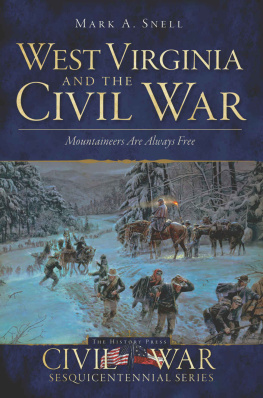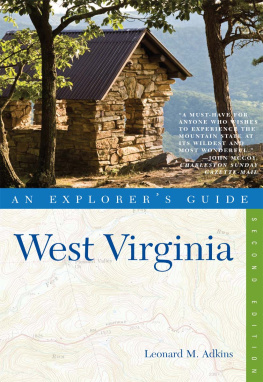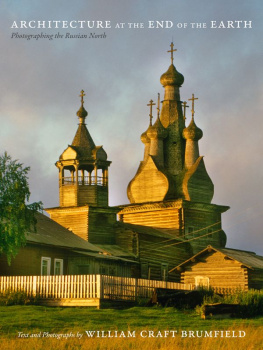PELICAN PUBLISHING COMPANY
Gretna 2014
Copyright 2014
By Brandon Kirk
All rights reserved
The word Pelican and the depiction of a pelican are
trademarks of Pelican Publishing Company, Inc., and are
registered in the U.S. Patent and Trademark Office.
Library of Congress Cataloging-in-Publication Data
Kirk, Brandon R.
Blood in West Virginia : Brumfield v. McCoy / by Brandon Kirk.
pages cm
Summary: In 1880s West Virginia, Green McCoy and Milt Haley were paid to kill Allen Brumfield and were punished for the crime. Using newspaper archives, courthouse documents, rare photographs, and interviews with descendants (the author is one), this gripping book follows the all-out feud that resulted--Provided by publisher.
Includes bibliographical references and index.
ISBN 978-1-4556-1918-4 (hardcover) -- ISBN 978-1-4556-1919-1 (e-book) 1.
Brumfield, Allen. 2. Brumfield family. 3. Vendetta--West Virginia--Lincoln County--History--19th century. 4. Attempted murder--West Virginia--Lincoln County--History--19th century. 5. McCoy, Green, -1889. 6. Haley, Milt, -1889. 7. Runyon, John W. 8. Lincoln County (W. Va)--History--19th century. 9. Harts (W. Va)--Biography. I. Title.
HV6452.W42B78 2014
364.1523092275443--dc23
2014002977
Printed version printed in the United States of America
Published by Pelican Publishing Company, Inc.
1000 Burmaster Street, Gretna, Louisiana 70053
For John Hartford, my best friend
Benjamin Ben Adams
Timber boss, splasher, and saloon operator
Caanan Cain Adkins
United Baptist preacher, doctor, and justice of the peace
Mariah Vance Adkins
Cain Adkins wife, Green McCoys mother-in-law
Allen Al Brumfield
Storekeeper, boomer, and whisky boat operator; attacked on Harts Creek
Ann Toney Brumfield
Paris Brumfields wife
Charles Brumfield
Al Brumfields brother
Hollena Hollene Dingess Brumfield
Al Brumfields wife; attacked on Harts Creek
John Brumfield
Al Brumfields brother
Paris Brumfield
Al Brumfields father; storekeeper, distiller, and timber man
David Dave Dingess
Henderson Dingesss son; wounded in the attack on the Brumfields
Floyd Dingess
Henderson Dingesss son; murdered by his brother-in-law Billy Hall in 1888
Henderson Dingess
Hollene Brumfields father; farmer and distiller
Hugh Dingess
Henderson Dingesss son; farmer and timber man
Catherine Cat Fry
Eyewitness to the Haley-McCoy murders
Imogene Emmy Mullins Haley
Milt Haleys wife
Thomas Milt Haley
Accused of shooting Al and Hollene Brumfield
Monterville Q. Boney Lucas
Timber man; murdered by Paris Brumfield
Spicie Adkins McCoy
Green McCoys wife; daughter of Cain Adkins
Green A. McCoy
Accused of shooting Al and Hollene Brumfield
John W. Runyon
Timber boss, store keeper, saloon operator, and deputy sheriff
Elias Vance
Lincoln county justice of the peace
Benjamin Ben Walker
Organized the Haley-McCoy burial party

This book offers a construction of events based on lengthy and prolonged interviews of participants close descendantsthe oldest of whom was born in 1899and an investigation of official records, publications, and manuscripts stored in dozens of courthouses, libraries, and archives located in two states. To the scores of contributors who, during the past twenty years, have offered inspiration, hospitality, information, encouragement, and cooperation, thank you. A special note of gratitude is extended to my personal sources: the many relatives of feudists, most born prior to 1930, who became first and foremost dear friends and will forever remain etched in my memory. Without their assistance, none of this would have been possible. I would like to specifically acknowledge those whose contributions were essential: Ray Kirk, my grandfather, who first told me of the feud; Fred B. Lambert, regional historian and educator, whose passion for and research into similar matters nearly a century ago provided inspiration; Billy Adkins, genealogist and local historian, who offered mentorship and invaluable insight into the Harts Creek community; and Phyllis Kirk, my mother, a retired English teacher who suggested the framework for presentation of this material. Lastly, thanks are due to Erin Classen, my editor at Pelican.
We shall not cease from exploration,
and the end of all our exploring will be
to arrive where we started
and know the place for the first time.
T.S. ELIOT
Little Gidding

The town of Hart as it existed in 1889 lay among the fertile river bottoms of southwestern West Virginia, a location ripe in timber and moonshine. Situated at the mouth of Big Harts Creek and bisected by the northwestward-flowing Guyandotte River , it consisted of a few plank and log farmhouses intermixed with a handful of general stores and a mill. A dreary but prosperous little spot, some twenty miles east of the Kentucky border, it offered no banks or streetsjust farms with businesses. Within its boundaries lived a patchwork of farmers, merchants, timber men, preachers, masons, blacksmiths, millers, and distillers. Accessed by the county road, a dirt trail that crossed the river just below town, Hart was boxed in to the east and west by two rolling stretches of hills. To the south was Big Harts Creek itself, a ten-mile long stream with steep slopes lined by valuable timber to be cut, rafted, and sold in the Ohio River markets. The entire community straddled a county line: the town and surrounding environs constituted Lincoln County s southernmost district, while Upper Hart made up a sort of backcountry region in Logan County . Aracoma , a fur-trading timber spot some twenty miles upriver, was the closest town of any size (population 325).
Generally, residents lived similarly to their pioneer ancestors, the earliest of whom had arrived in the valley some ninety years before. Most dwelled in log cabins made of timber that they themselves had cut from surrounding hills. They spent nearly every waking minute engaged in the chores of farm lifemilking, feeding, plowing, cutting, clearing, storing. Life was difficult, routine, consuming. There was no time to be sick or hurt. People grew almost everything, raised almost everything, did almost everything. They built cribs, sheds, fences, boats, sleds. They made clothes, quilts, furniture, tools, soap, liquor. When time permitted, they hunted wild game, gathered berries and herbs, and fished in the creeks and river. Somehow, they found time to interact with one another. They congregated at general stores, attended church services and singing schools, and mourned together at funerals. They bartered goods, swapped stories, told tall tales, and scuffled at elections. They played cards, frolicked at dances, and debated the Bible. They raised barns, grubbed land, built roads, and participated in bean stringings and corn shuckings. People got along quite wellin a sense, the community was one large extended family.


















